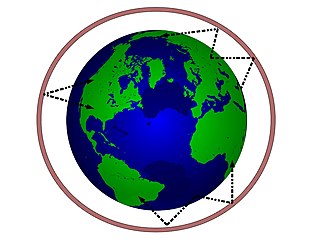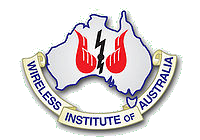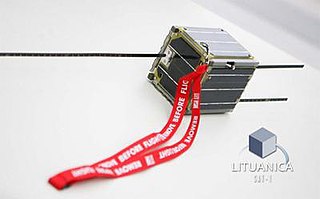
The ionosphere is the ionized part of the upper atmosphere of Earth, from about 48 km (30 mi) to 965 km (600 mi) above sea level, a region that includes the thermosphere and parts of the mesosphere and exosphere. The ionosphere is ionized by solar radiation. It plays an important role in atmospheric electricity and forms the inner edge of the magnetosphere. It has practical importance because, among other functions, it influences radio propagation to distant places on Earth. It also affects GPS signals that travel through this layer.

In radio communication, skywave or skip refers to the propagation of radio waves reflected or refracted back toward Earth from the ionosphere, an electrically charged layer of the upper atmosphere. Since it is not limited by the curvature of the Earth, skywave propagation can be used to communicate beyond the horizon, at intercontinental distances. It is mostly used in the shortwave frequency bands.
AMSAT is a name for amateur radio satellite organizations worldwide, but in particular the Radio Amateur Satellite Corporation (AMSAT) with headquarters at Washington, D.C. AMSAT organizations design, build, arrange launches for, and then operate (command) satellites carrying amateur radio payloads, including the OSCAR series of satellites. Other informally affiliated national organizations exist, such as AMSAT Germany (AMSAT-DL) and AMSAT Japan (JAMSAT).

The Wireless Institute of Australia (WIA) was formed in 1910, and is the first and oldest national amateur radio society in the world. It represents the amateur radio operators of Australia as the AR "peak body" in dealings with the Australian Communications and Media Authority (ACMA), the authority under the government of Australia that administers communications within and external to Australia. The WIA publishes a bi-monthly journal for its membership called Amateur Radio. The organisation is the national society representing Australia in the International Amateur Radio Union.

The International Amateur Radio Union (IARU) is an international confederation of national organisations that allows a forum for common matters of concern to amateur radio operators worldwide, and collectively represents matters to the International Telecommunication Union (ITU). The International Amateur Radio Union was founded in 1925 and, as of July 2021, it is composed of 172 national member societies.

Radio Amateurs of Canada (RAC), known in French as Radio Amateurs du Canada, is the national association for Amateur Radio in Canada. It is a not-for-profit membership association with headquarters in Ottawa, Ontario, Canada, representing the interests of Amateur Radio all across Canada. Speaking on behalf of Canadian Radio Amateurs, RAC provides liaison with government agencies and carries the Amateur voice about regulatory and spectrum issues to the discussion table with government and industry leaders, nationally and internationally.
The 2-meter amateur radio band is a portion of the VHF radio spectrum that comprises frequencies stretching from 144 MHz to 148 MHz in International Telecommunication Union region (ITU) Regions 2 and 3 and from 144 MHz to 146 MHz in ITU Region 1 . The license privileges of amateur radio operators include the use of frequencies within this band for telecommunication, usually conducted locally with a line-of-sight range of about 100 miles (160 km).
HAMSAT also known as HAMSAT INDIA, VU2SAT and VO-52 is a microsatellite weighing 42.5 kilograms (93.7 lb), providing amateur radio satellite communications services for Indian and international amateur radio operators. This satellite carries the in-orbit designation of VO-52, and is an OSCAR series satellite.

The 60-meter band or 5 MHz band is a relatively new amateur radio allocation, first introduced in 2002, that was originally only available in a few countries, such as the United States, United Kingdom, Norway, Finland, Denmark, Ireland and Iceland. Over a number of years however, an increasing proportion of countries' telecommunications administrations – together with their government and military users – have permitted Amateur Radio operation in the 5 MHz area on a short or longer-term basis, ranging from discrete channels to a frequency band allocation.
Amateur radio frequency allocation is done by national telecommunication authorities. Globally, the International Telecommunication Union (ITU) oversees how much radio spectrum is set aside for amateur radio transmissions. Individual amateur stations are free to use any frequency within authorized frequency ranges; authorized bands may vary by the class of the station license.

Amateur radio international reciprocal operating agreements permit amateur radio operators (hams) from one country to operate a station whilst traveling in another without the need to obtain additional licenses or permits.
The New Zealand Association of Radio Transmitters (NZART) is a non-profit organisation of amateur radio enthusiasts in New Zealand. It represents New Zealand amateur radio operators nationally and internationally. NZART is a founding member of the International Amateur Radio Union. It is an association of individual members, however those members are encouraged to form local branches.
SumbandilaSat, was a South African micro Earth observation satellite, launched on 17 September 2009 on a Soyuz-2 launch vehicle from the Baikonur Cosmodrome. The first part of the name, Sumbandila, is from the Venda language and means "lead the way".

Amateur radio, also known as ham radio, is the use of the radio frequency spectrum for purposes of non-commercial exchange of messages, wireless experimentation, self-training, private recreation, radiosport, contesting, and emergency communications. The term "amateur" is used to specify "a duly authorized person interested in radioelectric practice with a purely personal aim and without pecuniary interest"; and to differentiate it from commercial broadcasting, public safety, or professional two-way radio services.
Amateur radio call signs in Africa are codes used to identify all radio communications, broadcasts and transmissions. The International Telecommunication Union assigns Africa as ITU region #1. It has assigned call signs prefix blocks to countries including 77 DXCC entities in and off-shore of Africa. Western Sahara is not a DXCC entity but uses SØ as a prefix.
An amateur radio satellite is an artificial satellite built and used by amateur radio operators. It forms part of the Amateur-satellite service. These satellites use amateur radio frequency allocations to facilitate communication between amateur radio stations.

LituanicaSAT-1 was one of the first two Lithuanian satellites. It was launched along with the second Cygnus spacecraft and 28 Flock-1 CubeSats aboard an Antares 120 carrier rocket flying from Pad 0B at the Mid-Atlantic Regional Spaceport on Wallops Island to the International Space Station. The launch was scheduled to occur in December 2013, but later was rescheduled to 9 January 2014 and occurred then. The satellite was broadcasting greetings of Lithuanian president, Mrs. Dalia Grybauskaitė. The satellite was deployed from the International Space Station via the NanoRacks CubeSat Deployer on February 28, 2014. All LituanicaSAT-1 subsystems have been turned on, tested and proved to be working properly. The mission is considered a complete success by its team of engineers. The mission ended upon the reentry and disintegration of the satellite on July 28, 2014.

Es'hail 2 is a Qatari satellite, launched aboard a SpaceX Falcon 9 rocket on November 15, 2018. Es'hail 2 was built by Japan's Mitsubishi Electric company, and operates at 26° East longitude along a geostationary orbit to provide direct-to-home television services in the Middle East and North Africa region. The satellite features 24 Ku-band and 11 Ka-band transponders to provide direct broadcasting services for television, government and commercial content distribution. In addition to commercial services, the payload of Es'hail 2 includes a linear transponder with a bandwidth of 500 kHz and 8 MHz for the amateur radio satellite service, with uplink on 2.4 GHz and downlink on 10.45 GHz.
The International Beacon Project (IBP) is a worldwide network of radio propagation beacons. It consists of 18 continuous wave (CW) beacons operating on five designated frequencies in the high frequency band. The IBP beacons provide a means of assessing the prevailing ionospheric signal propagation characteristics to both amateur and commercial high frequency radio users.
The 8 meter band (40 MHz) is at present the lowest portion of the very high frequency (VHF) radio spectrum allocated to amateur radio use. The term refers to the average signal wavelength of 8 meters.











